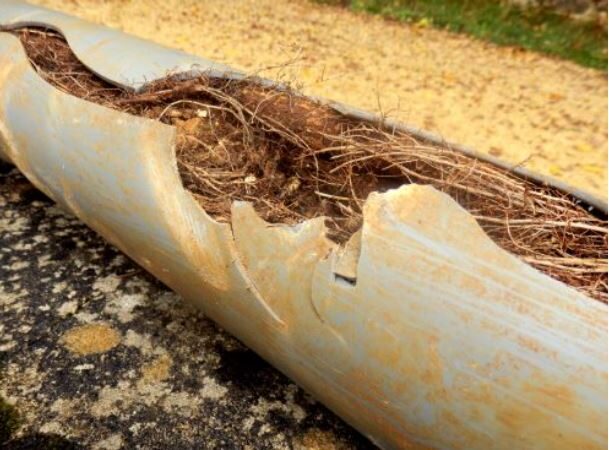You may have heard the expression, “Call before you dig.” Many localities use this phrase to remind residents to call the city or town they live in to check for pipes and sewer lines before digging and planting. This is to help locate the presence of underground utilities before you start digging so you don’t strike anything that’s dangerous or costly.
But you may be wondering how to stop roots from growing into pipes once a tree is already planted. After all, a tree’s roots can cause just as much damage as a shovel if they’re not properly managed. The taller the tree, the further its root system will travel, threatening underground utilities and even the structural integrity of your property.
It’s easiest to nip this problem in the bud before it becomes a full-blown issue. We’ll let you know how and tell you what to do if you suspect you already have roots growing into your pipes.
Plant Carefully
If you haven’t already planted the tree, the first thing you should do is “call before you dig.” In the US, homeowners can call 811 for their state, which is available 24 hours a day, 7 days a week to locate underground utilities on their property. Many states have the option to submit a utility locate request online. Once you have been informed of where underground utilities are located, you can start planning your dig.
But it’s not simply enough to “know what’s below.” You also have to measure out the appropriate distance from pipes to plant your tree. Generally speaking, trees should be planted at least 10 feet away from sewer lines.
The University of Tennessee Agricultural Extension has some other great recommendations for how to stop roots from growing into pipes. First, if you plan to plant near sewer lines, you should select a tree that’s small and slow-growing. If you do decide to plant a tree that’s faster-growing, be prepared to replace it every 8 to 10 years. Though this will require tree removal, it will be much less expensive to pay for tree removal services than it will be to replace a compromised pipe system.
Keep in mind that some trees have more aggressive root systems than others. These trees, such as cottonwoods and willows, should be planted even further away from sewer lines. Other trees, like the Japanese maple or the eastern redbud, are generally safer to plant. They also grow in Plant Hardiness Zones 5 to 9, making them ideal options for the Pacific Northwest. Do your research before planting to determine which trees are the best options for your yard.
Create a Physical Barrier
You can also erect a physical barrier that will serve as a blockade to keep the tree’s roots from encroaching on your home’s pipe system. Solid barriers are designed to be impenetrable and are typically made of metal, fiberglass, or plastic. Permeable barriers, on the other hand, are designed to allow water and smaller roots to travel through them. Ideally, you should erect a physical barrier as a preventative measure when you first plant the tree. SFGate has some good tips for how to construct a successful tree-root barrier.
Use a Chemical Solution
You’re probably wondering how to stop roots that are already growing into your pipes. Though prevention is always the best solution, there is something you can do to slow root growth if your tree’s roots are encroaching on your home’s pipes. For instance, there are a couple of chemical solutions you can use to inhibit root growth.
Copper sulfate, for example, is an herbicide used to destroy invasive roots. Keep in mind, though, that many chemicals, such as copper sulfate, are toxic. Therefore, you’ll need to consult with your local and state ordinances to see whether or not you’re able to use them in your area.
If copper sulfate is approved for use where you live, you will simply pour the copper sulfate directly into your toilet and flush it down the drain. Wait 10 minutes and then repeat this process several more times. As mentioned, copper sulfate is toxic to animals so be sure to remove pets from your home and open windows to allow the house to air out before allowing them back inside. Wait a few hours and then flush your toilet again to assess whether the sewer lines have been cleared.
If copper sulfate is not allowed in your area, you still have some options. You can use a foaming tree root killer containing dichlobenil, which kills roots and prevents future growth. As you would with the copper sulfate, you will pour the solution into the toilet closest to the home’s main drain and flush. Wait for the toilet to refill and then flush again. Wait six to eight hours before using the toilet to give the solution time to work.
Call in the Experts
One way to prevent roots from growing into pipes is through regular maintenance. An expert arborist can help you spot a potential problem before it becomes a major issue. Though routine maintenance will cost you up-front, it can save you a significant amount of money in the long run.
If it’s too late for preventative maintenance because you already have roots growing into your pipes, call in a certified plumbing technician to help. A plumbing technician can assess the condition of your pipes and make an appropriate recommendation.
Root control specialists may also be able to use special tools and instruments to remove existing root growth. If the tree’s root system cannot be managed, a tree service company may need to be called in to remove the tree.
If you reside in the Portland area and are in need of tree services, Mr. Tree can help. Remember, the sooner you call in reinforcements, the better off you’ll be.

